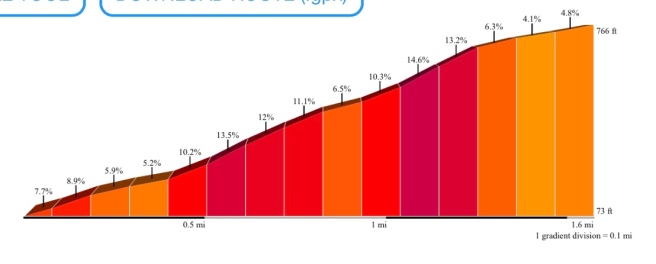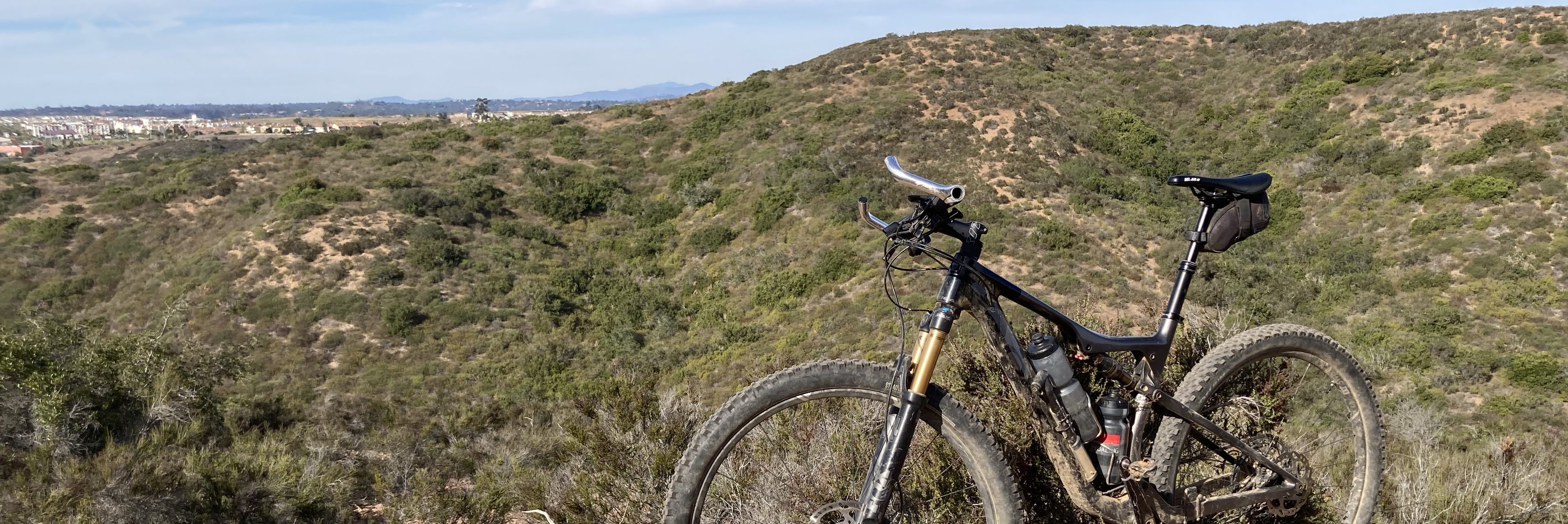I decided to try the via Capri climb the other day after doing two repeats up Torrey Pines. Now, admittedly, I was slacking it up the TP climb. But I was running around 55-60 rpm cadence in the 3rd and 4th cogs, so it was not a complete spin. And the reason I was doing the climb slow and easy was because of a 875 foot vertical, 3 mile round trip hike I’d done the day before.
I have not been doing much weight bearing exercise in the past four years. I have been doing zero hiking.
My quads were not in great shape from the start of the ride.
At any rate, the TP climbs left me feeling ambitious, I guess. The new gearing scheme had me in the third and fourth cogs going up and still feeling okay. This is because the 32/22 (4th cog) at 39.9 gear inches matches up to the 39/27 39.6 inches of the previously lowest gear. Feeling normal-to-good in the lowest gear I’ve been riding on the road bike for decades.
So I got it in my head that it was time to try out the way that the new 32 / 32 hotness felt on the steep pitches of via Capri.

I failed.
I had to stop somewhere in the 13.2% gradient section. It was legs, not lungs, that called a halt. I was nearing 160 bpm, pretty near my top end right now, but I probably could have kept it there for a few more minutes. However, the legs gave out. I took a brief rest and then finished it off to the cross.
I like having a climb this steep where I can check the gradient for each section and compare that with the sense of difficulty on road. Strava gives point estimates of as high as 16.6% gradient within the main steep bit, which is smoothed out into 0.1 mi segments in the figure. And this is something that feels brutally steep. I can ride it from the saddle but I’m pretty far out on the nose of it, like a MTB climb.
But this is only a 2.5 km ascent. This is not that long. And it really gives perspective when the commentators on pro cycling give the climb numbers for a race and you realize this climb should barely trouble the sprinters, given the short length.
The famed Col du Tormalet runs 7% and then 8% for most of it, but it is an 18 km total climb distance. The equally famous Alpe d’Huez has sections of 7%-9% mostly, with a 10% section at the bottom. But it’s 14 km total and the 10% runs for a kilometer.
Correspondingly, other familiar local gradients can help us come to grips with, say, why a sprinter like Jasper “Disaster” Philipsen was able to make it over the Poggio in Milano-San Remo in touch with the climbers. That’s because the Poggio is a mere 3.6 km climb with gradients of 3%-5% at the steepest and the longest sustained 5% section is only 0.4 km. The earlier Cipressa climb is likewise only 3%-5% and it runs 5.5 km. The bigger guys can sustain the extra power needed for limited numbers of kilometers over these moderate inclines. It is only the 10 km plus grinds, and the steeper gradients that let the lightweight climbers easily dance away to gain minutes. If they want to use the Cipressa or Poggio to drop the larger riders, it is a much harder task and they run out of room to gain seconds or minutes.
Casting about for something similar on local roads, Torrey Pines is a fairly steady 6% climb with a few sections that near 7%, and it is about 2.25 km in length. Steeper than the two famous climbs of Milano-San Remo, albeit shorter than even the Poggio. And I see local dudes big ringing the TP climb all the time.
The top 1.2 km of the Soledad Mt Road climb is perhaps a better comparison, it runs 2%-5%, about evenly split at the 4% threshold. This does come after about 0.6 km of 7% gradient so it can feel harder if you’ve killed yourself on the early part, but it also provides contrast with the lower gradients above which seem easy by comparison.
For me there’s a cutoff somewhere around a 4%-5% gradient. Below this is riding. Above this is climbing. Also known as suffering. And when I am group riding, this is also known as “getting dropped”. Or at least risking getting dropped.
Even back in the day when I was much, much lighter and much more powerful, the gradient cutoffs were about the same. Reason being, you never go any easier, you just ride faster. So whether it was the fast group in my 20s or the D ride now, the same sections put the hurt on me relative to others in the group ride. The start of El Camino Real is 6% but then it slackens off to 3% or less….until one more 6%ish pitch at the top. These were places I needed to strategize back in the day to keep from blowing up and they are similar problems now. Back then more of the ride would arrive together at Torrey Pines…and I would promptly get dropped.
I am bad at climbing. I have always been bad at climbing.
But I persist.

“you never go any easier” covers so much in life … I think you have a book trying to get out Mike